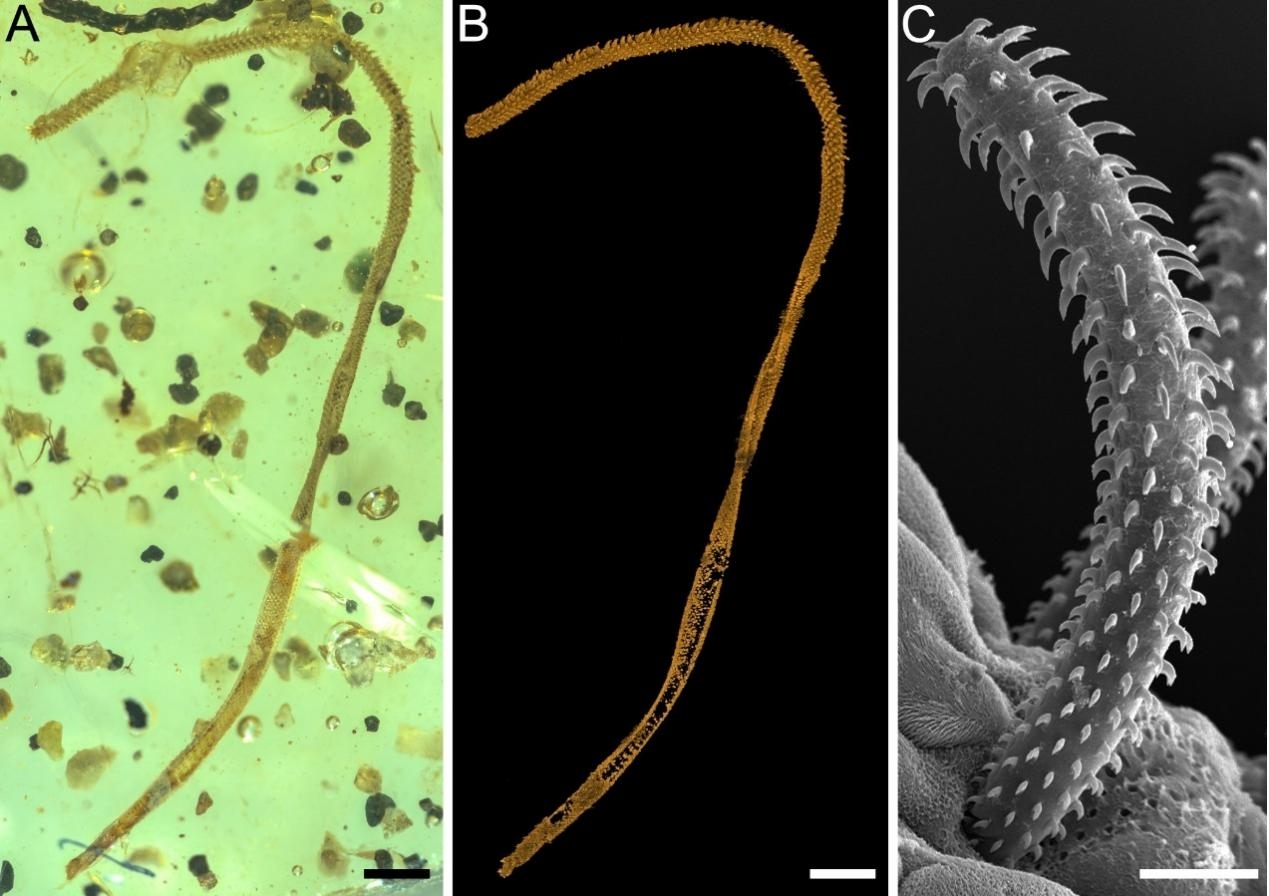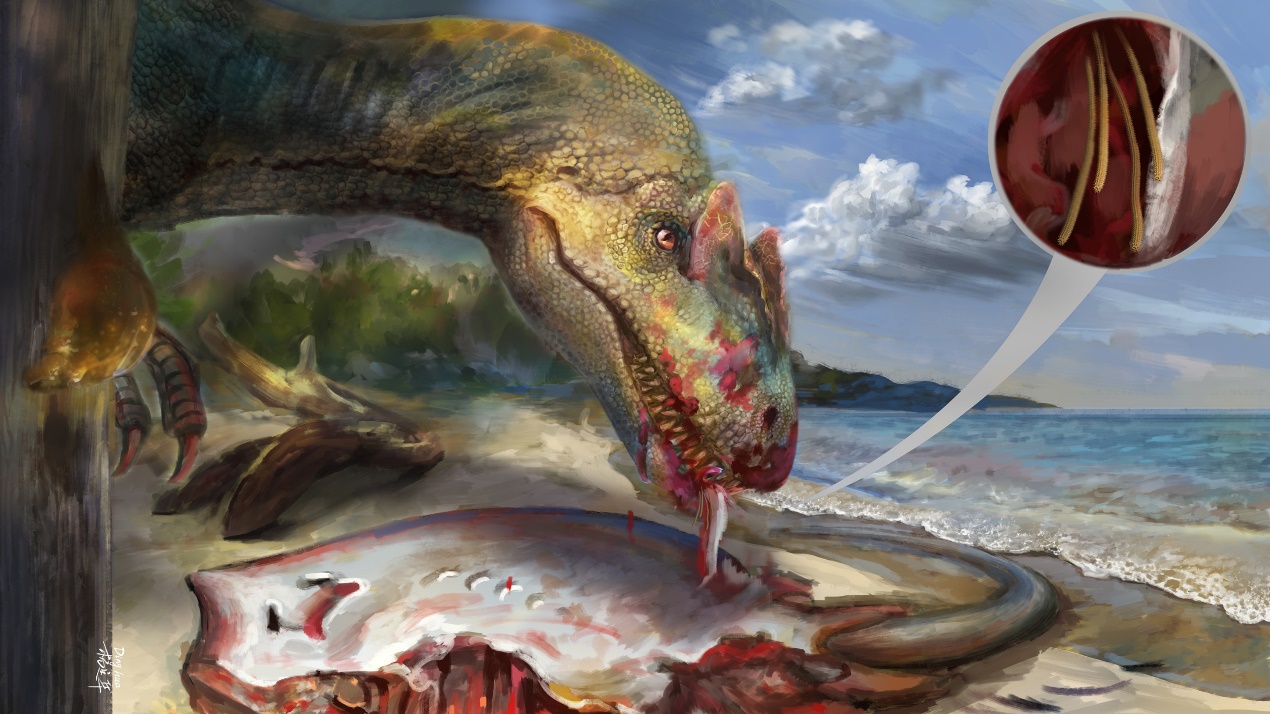Cestoda, commonly known as tapeworms, is a large class of the platyhelminth phylum with about 5000 species described to date. Recently, LUO Cihang, a PhD candidate, supervised by Prof. WANG Bo from the Nanjing Institute of Geology and Palaeontology of the Chinese Academy of Sciences (NIGPAS), collaborated with other scientists from Yunnan University, and Germany, UK, , Myanmar, reported an enigmatic fossil from mid-Cretaceous Kachin amber (about 100 million years ago), on Geology on March 22, 2024.
This study thus probably provides not only the first partial body fossil of a tapeworm, but also arguably the most convincing body fossil of a flatworm, providing new evidence for the early evolution of tapeworm.
Cestoda infect all major groups of vertebrate animals including humans and livestock, and can be found in almost all marine, freshwater, and terrestrial ecosystems. Their size is variable, ranging from less than 1 millimetre to more than 30 meters in length. Tapeworms are usually characterized by adults with a scolex (grasping head), a short neck, and a segmented body formed of multiple sets of genital organs (proglottids). Their scolex typically has hooks, suckers, or hooked tentacles, which can help them clung to the alimentary tract of their hosts. Most tapeworms have an obligatory parasitic life cycle involving two or three hosts. They have no mouth and digestive tract, and absorb nutrients directly from the gut of their hosts.
The Order Trypanorhyncha is the most speciose tapeworm group in the marine realm, and it comprises one of the most ubiquitous and readily recognized parasites of marine fish. Trypanorhynch tapeworms are characterized by a scolex bearing 2 or 4 bothria, and a unique tentacular apparatus with four evaginable tentacles adorned with hooks as extensions of tentacle sheaths inside the scolex. Their larvae infect a wide variety of marine invertebrates (like crustaceans), as well as teleosts, and their adults are found in the stomach and intestine of sharks and rays.
Molecular clock analyses calibrated by means of host fossil data estimate that trypanorhynch tapeworms had probably originated around the Triassic/Jurassic boundary (about 200 million years old), but their own fossils have never been found. In summary, the fossil records of tapeworms are extremely sparse due to their soft tissue and endoparasitic habitats, which greatly hampers our understanding of their early evolution.
This fossil displays unique external (armature pattern) and internal (partially invaginated tentacle and rootless hooks) features which are most consistent with the tentacles of extant trypanorhynch tapeworms that parasitize marine elasmobranchs (mainly sharks and rays). Remarkably, nearly all extant trypanorhynchs are endoparasites of marine elasmobranchs, thus our study provides an exceptional example of a marine endoparasite trapped in amber, and sheds new lights on the taphonomy of amber.
WANG says, “we reported the first body fossil of a tapeworm.” Tapeworms are thought to originate from the mid-Paleozoic based on their molecular framework, but their fossil record is extremely scarce due to their endoparasitic lifestyle. Although supposed tapeworm eggs were reported from a Carboniferous shark coprolite, the only widely accepted fossil record before the Quaternary is restricted to eggs discovered in a shark coprolite from the Permian, suggesting that the relationship between tapeworms and elasmobranch vertebrates was established at least by then. Although a tapeworm embryo was reported inside an egg, but it is putative due to the lack of confirmed characters. The new fossil is most consistent with the tentacle anatomy of a trypanorhynch tapeworm including the hook morphology, and thus represents the first body fossil of a tapeworm from the geological past.
The new fossil presented the most convincing body fossil of a platyhelminth. Body fossils of the platyhelminth phylum are rare, with only a few examples. The oldest putative record comes from the Devonian of Latvia: circlets of hooks with sucker discs were found on placoderm and acanthodian fish. Although the arrangement of hooks is consistent with extant monogeneans, no other body structure was found. Two cysts that resemble trematode metacercariae were reported from mid-Cretaceous Kachin amber, however, no valid morphological details were given to support this. Lastly, the body fossil of Rhabdocoela discovered in Eocene Baltic amber has been plausibly reinterpreted as air bubbles. Therefore, this find represents the most convincing body fossil of a platyhelminth that has yet been found.
The research indicated amber can preserve the internal structure of helminths. Using high resolution micro-CT, this study discovered that inside the fossil is a folded longitudinal structure appearing to run in a spiral around the longitudinal axis and it extends to the anteriormost part. This is in accordance with the invaginated tentacle of a trypanorhynch. Meanwhile, the rootless hooks are also the same as those of trypanorhynchs. Previous research has indicated that the internal structure can be preserved intact as in extant forms, but these studies are all focused on arthropods. “Our results highlight that amber can preserve the internal structure of helminths like tapeworms on geologic time scales”, says WANG.
The research results provided a remarkable example of a marine endoparasite trapped in amber. Some gleicheniacean trichomes and one scale insect nymph are preserved together with the partial worm fossil in the same amber specimen, clearly indicating a terrestrial or onshore environment at the time of entrapment in resin. Moreover, there are many sand grains uniformly distributed inside the amber, implying that entrapment of the fossil occurred in a sandy environment. Furthermore, previous evidence shows that Kachin amber was deposited in a near-shore environment.
Therefore, a possible scenario can be proposed: the elasmobranch host of the tapeworm was stranded by a tide or storm, for example. The trypanorhynch had an extruded tentacle in the dying host, and its host was bitten by a higher-level terrestrial predator or scavenger; when the host was ingested by the predator, the tentacle was pulled apart from the trunk, dislodged from the intestine and came stuck to some nearby resin. “Our study further supports the hypothesis that Kachin amber was probably deposited in a paralic paleoenvironment, and also highlights the importance of amber research in paleoparasitology”, add WANG.
This research was supported by the National Natural Science Foundation of China, the Second Tibetan Plateau Scientific Expedition and Research, and the Deep-time Digital Earth (DDE) Big Science Program.
Reference: Luo Cihang, Palm H.W., Zhuang Yuhui, Jarzembowski E.A., Nyunt T.T., Wang Bo, 2024. Exceptional preservation of a marine tapeworm tentacle in Cretaceous amber. Geology. https://doi.org/10.1130/G52071.1.

The fossil tapeworm from mid-Cretaceous Kachin amber (~99 Ma; million years ago) and the comparison with the tentacle of an extant trypanorhynch tapeworm. (A) Microscopic image of fossil tapeworm. (B) Micro-CT image of fossil tapeworm. (C) Scanning electron microscopy image of an extant trypanorhynch tapeworm.

The comparison of the internal structure of the fossil (A) with the tentacle of an extant trypanorhynch tapeworm (B). Abbreviation: ivt—invaginated tentacle.

A hypothetical ecological reconstruction of the fossil trypanorhynch tapeworm (drawn by YANG Dinghua.
Contact:
LIU Yun, Propagandist
Email: yunliu@nigpas.ac.cn
Nanjing Institute of Geology and Palaeontology, Chinese Academy of Sciences
Nanjing, Jiangsu 210008, China
Download:
